










 |
 |
 |
 |
 |
 |
||
 |
 |
 |
 |
 |
sums will set you freehow to teach your child numbers arithmetic mathematicsfractions, decimals, percentages and ratios 1 |
||
|
|
||
|
||||||||||||||||||||||||||||||||||||||||||||||||||||||||||||||||||||||||||||||||||||||||||||||||||||||||||||||||||||||||||||||||||||||||||||||||||||||||||||||||||||||||||||||||||||||||||||||||
fractions, probability, percentage and proportionSay one in a hundred fish are blue, this can be expressed and written numerically in several manners.
fractions,
decimals, percentages and ratios
|
||||||||||||||||||||||||||||||||||||||||||||||||||||||||||||||||||||||||||||||||||||||||||||||||||||||||||||||||||||||||||||||||||||||||||||||||||||||||||||||||||||||||||||||||||||||||||||||||
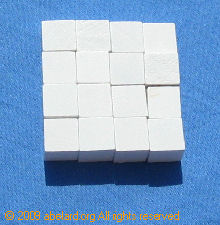 |
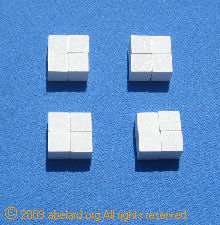 |
Now back to the cake divided into four. Notice that we started by calling it one cake and now we have four quarters of one cake, or block.
 |
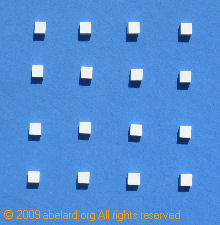 |
If each of the quarters is then divided into four, so there are four quarters of each quarter, then the original whole cake, or block, will now be divided into sixteen parts.
In the written fraction ¼, the one above the line shows how many parts are included in the fraction (of the cake or block or anything you choose) - in this case one part, while the number below the line shows or indicates how many parts the complete object (cake, or anything) is divided.
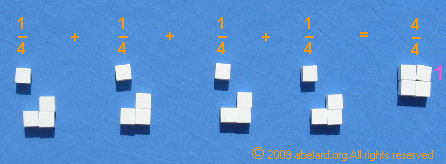 |
|
| Remember, the
equals sign is a sort of balance point in an equation (sum) |
 |
See that if you add quarter of a cake to quarter of a cake, ¼ + ¼, you now have two quarters 2/4, or half a cake. Obviously, that is written as one over two, ½ , this can be described as one cake divided into two. If you add a quarter to a quarter to a quarter to a quarter, ¼ + ¼ + ¼ + ¼, you now have the whole cake, that is one cake, which can be written as 4/4, while three quarters of the cake will be written as ¾.

As you will notice, the four quarters of the cake, 4/4 [2], which as already said means four divided by four, and we know very well that four divided by four is one - that is in this case, one cake.
Now it is important for an understanding of fractions, that at each stage the numbers are attached clearly to the physical objects and the manipulation of those physical objects. As we build this connection, it will later mean that as the learner moves to calculating with the numbers, they will acquire a feel for whether the sums make sense. The learner will be able to return to cakes and blocks, if confused, in order to make sure that the sums work in the real world.

We have two quarters 2/4, which we then said is half a cake ½, and simply, by looking at the cake or the blocks, you can immediately see with your eyesy-piesyes that two quarters of the cake is indeed half the cake. Thus it is clear that half is the ‘same’ as (equal to) two quarters: 1/2=2/4.
If you look closely, you will see that, in the expression 2/4, if we divide the two by two, the result is one; and if we divide the four by two, the result is two. That is by carrying out this rule - do the same to the top and to the bottom - the result works in this case. Soon we shall move on to see whether this magical performance will continue to work in all other circumstances.
If we go up the leaning Tower of Pisa and drop stones, we will see that the stones usually fall to the ground, maybe sometimes bouncing of the heads of passers by. Of course, you can try this while sitting on a chair, when you may bean a mouse. That these objects fall when you let go of them, eventually becomes so obvious and happens with such predictability, that you decide that this phenomenon is a rule in the real world. If you drop a computer, or an elephant, or even yourself, each will fall. So, when you pick yourself up, be careful not to drop yourself.
In due course, you will probably be prepared to agree that when you divide (or multiply) the top and bottom parts of a division sum, or fraction, by the same number, the value after these divisions or multiplications (the value being the amount of cake) does not vary from the fraction before the division or multiplication. 50/100, 6/12, 4/8, 3/6, 2/4, 1/2 are all equivalent fractions and all indicate one half.
Some examples of simple additions with fractions:
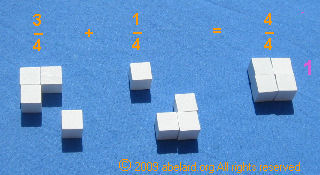
three quarters plus one quarter equals four quarters,
which equals one
3/4 + 1/4 = 4/4 = 1
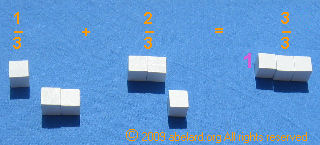
one third plus two thirds equals three thirds, which equals
one
1/3 + 2/3 = 3/3 = 1
Some examples of simple subtractions with fractions:
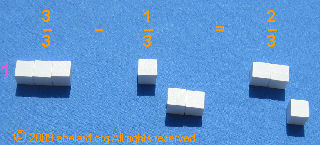
one minus one third equals two thirds: 1- 1/3 = 2/3
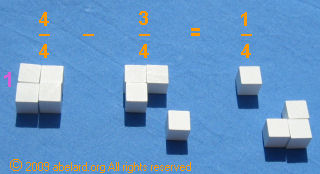
one minus three quarters equals one quarter : 1 - 3/4
= 1/4
Note that with these simple sums, the number underneath - the divisor or denominator - is the same for all parts of the sum. Each fraction being added the same sort of fraction, for instance: quarters, or tenths, or eighteenths.
Simple multiplications and divisions with fractions are on the next page - fractions, decimals, percentages and ratios 2. That deals with more complicated fraction sums.
These are fractions such as one and a quarter: 1 1/4.
Adding such fractions is found in sums such as
1 1/4 + 1 1/4, or 2 1/5 + 3 2/5.
When adding such fractions together, you add the whole
numbers together and add the fractions together:
1 + 1 + 1/4 + 1/4.


Oh wow, you say, 8/6 is more than 6/6 (or one)!
Yes, so split 8/6 into a whole number and a fraction by
subtracting 6/6 (that is, 1) from 8/6:
8/6 - 6/6 = 2/6.
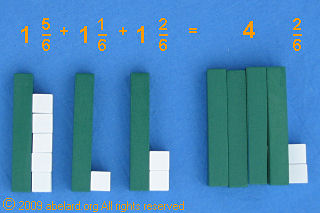
Using mixed-up fractions is a little more complicated, involving adding fractions like two thirds to one half: 2/3 + 1/2.
Starting with a simple example, a way of working out what is the common ‘bottom number’ of fractions in a sum is to lay out two rows of Cuisenaire rods, each row being made up of rods the length of one of the numbers being considered. For the sum 2/3 + 1/2, the two numbers would be 3 and 2.

Here you can see that three lots of two (red rods) is equivalent to two lots of three (green rods).
As you can see, one third of one is equivalent to two sixths, and one half is equivalent to three sixths. So we have two thirds, that is four sixths, and by adding the half, which is three sixths, we have seven sixths in all.
Thus, 
Looking back at the rod picture, you will see that the sixths go commonly into both the halves and the thirds. The sixths are the lowest common denominator, the biggest fraction that will divide into both the thirds and the halves. You will also notice that two times three equals six (2 x 3 = 6), thus multiplying the denominators together will give you at least one common fraction into which the fractions you wish to add may be divided.
![]()
As you cannot add thirds and fifths as they stand, any more than you can add apples and oranges and end up with plums, you have to turn the apples and oranges into a similar purée in order to add purée to purée. So our first job is to purée the different fractions that we are trying to add together.
What we can do is turn the thirds into ninths or twelfths, or turn the fifths into tenths or twentieths, but we still will not be able to add them together efficiently.
So what we are trying to do is to find a way of cutting the thirds and the fifths into the ‘same’ size chunks as each other. This is what the search for a lowest common multiple is all about. It is, in fact, about finding the biggest bits (or fractions) that we can divide both thirds and fifths into evenly. So, in fact, in a way, this is the biggest common bits we can make of both thirds and fifths. Once again, we have some rather clumsy jargon.
Now let’s set about finding these biggest common bits (fractions) or, as the jargon says, the lowest common multiple. As you can see from the photo-diagram below, you can turn thirds into fifteenths and you can divide fifths into fifteenths! You can look at the yellow blocks as being fives, or as being five fifths; and the green blocks as being threes, or being three thirds. Or you can look at the stretch of fifteen white blocks as being fifteenths. As usual, the way you count depends entirely on your purpose.

As you can see in this diagram, both the fifths (5ths, yellow) and the thirds (3rds, green) can be turned into fifteenths (15ths, white), and so can be added together with ease. Instead of one third and three fifths, we now have three fifteenths and nine fifteenths, which total twelve fifteenths.
Ah, Eureka, as Eratosthenes’ mate Archimedes expostulated, leaping out of his bath and running down the main street in his excitement - well, actually, in his birthday suit. And as reporters of his day tell it, he wasn’t even arrested. It sounds like they had more sense in those days, or in ancient Greece.
But enough of this jollity, back to our search for biggest bits.
![]()
adding one fifth and three eighths (1/5 + 3/8)
So we are standardising two fractions which, in the real world, could both be portions of a cake (or anything else) divided into the same number of parts.
Supposing we have one part of, say, a cake cut into five portions, to be added to three portions of a cake divided into eight parts: 1/5 + 3/8. It would be easier if the cake was divided into the same number of portions for each fraction.
Here is another way of visualising such as sum, which is also another way of visualising the lowest common multiple, this time of 5 and 8:
| 0 | 1 | 2 | 3 | 4 | 5 | 6 | 7 | 8 | 9 | 10 | 11 | 12 |
| 1 | 1 | 2 | 3 | 4 | 5 | 6 | 7 | 8 | 9 | 10 | 11 | 12 |
| 2 | 2 | 4 | 6 | 8 | 10 | 12 | 14 | 16 | 18 | 20 | 22 | 24 |
| 3 | 3 | 6 | 9 | 12 | 15 | 18 | 21 | 24 | 27 | 30 | 33 | 36 |
| 4 | 4 | 8 | 12 | 16 | 20 | 24 | 28 | 32 | 36 | 40 | 44 | 48 |
| 5 | 5 | 10 | 15 | 20 | 25 | 30 | 35 | 40 | 45 | 50 | 55 | 60 |
| 6 | 6 | 12 | 18 | 24 | 30 | 36 | 42 | 48 | 54 | 60 | 66 | 72 |
| 7 | 7 | 14 | 21 | 28 | 35 | 42 | 49 | 56 | 63 | 70 | 77 | 84 |
| 8 | 8 | 16 | 24 | 32 | 40 | 48 | 56 | 64 | 72 | 80 | 88 | 96 |
| 9 | 9 | 18 | 27 | 36 | 45 | 54 | 63 | 72 | 81 | 90 | 99 | 108 |
| 10 | 10 | 20 | 30 | 40 | 50 | 60 | 70 | 80 | 90 | 100 | 110 | 120 |
| 11 | 11 | 22 | 33 | 44 | 55 | 66 | 77 | 88 | 99 | 110 | 121 | 132 |
| 12 | 12 | 24 | 36 | 48 | 60 | 72 | 84 | 96 | 108 | 120 | 132 | 144 |
Here we use a cross table to work out which is the smallest number into which both 5 and 8 will divide (their lowest common multiple). The highlighted crimson numbers show that 5 and 8 are both multiples of 40.
Now looking back to the previous cases of 1/3 + 3/5, 1/5 + 3/8 and 2/3 + 1/2, notice that in each case we could find the biggest bits into which we can divide (split up) both fractions by multiplying the bottom numbers (denominators) together. So 3 x 5 gives 15ths, 5 x 8 gives 40ths and 2 x 3 gives 6ths.
Clearly, if we multiply 3 x 5, giving the result of 15, then 3 will go into 15 five times and 5 will go into 15 three times; and so on. But, as the numbers become bigger, it is sometimes thought helpful to continue to find the biggest bits that will go into each fraction, rather than deal in hundredths, or thousandths or seven thousand two hundred and twentieths (7,220ths) and onwards. Although, in these days of calculators and computers, we could really work work with whatever number that is obtained by multiplying any and all the denominators (bottom parts of fractions) together.
So now I am going to show you how your ancestors went about dealing with this problem in ‘the good old days’. For this next example, we will use the method of finding prime numbers of the bottom parts of the fractions, using the sum 7/20 + 7/12. Again, we are looking for the biggest bits (lowest common multiple) that go into both twentieths and twelfths.
We look for the prime factors of 20 and 12. To do this, start by dividing by the smallest prime factor you think will go until you run out of prime factors. I have an example here:
| 20 ÷ 2 =10 10 ÷ 2 = 5 and the remaining 5 is a prime number. So the prime factors of 20 are 2 x 2 x 5. |
12 ÷ 2 = 6 6 ÷ 2 = 3 and the remaining 3 is a prime number. So the prime factors of 12 are 2 x 2 x 3. |
Now examining these prime factors, the separate prime factors that make up both 20 and 12 are 2 x 2 x 3 x 5. 2 x 2 is common to both numbers, so 2 x 2 needs to be used just one time in making the common biggest bit.
We could, of course, just multiply 12 by 20 and deal in 240ths, but this way we only have to deal in 60ths (2 x 2 x 3 x 5).
So now to write out the sum of 7/20 + 7/12 in the old-fashioned style:
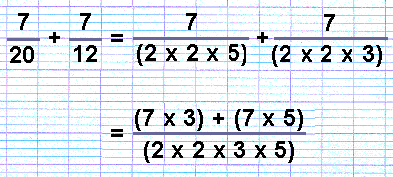
In the first line, the denominators (bottom parts) are expanded into their several factors.
In the second line, the denominators of the two fractions, 20 or (2x2x5) and 12 or (2x2x3), have been combined together (2x2x3x5). This results in the fraction 7/20, or 7/(2x2x5), being multiplied by 3 on the bottom part (that is, (2x2x5) x 3). So in order to keep this fraction balanced, we also multiply the top part by 3 (7x3).
1/(2x2x5) is 1/20, whereas 1/(2x2x5x3) is 1/60. There are, of course, 3/60ths in each 1/20. As there are 7/20ths in the original sum, 7/20ths therefore becomes 21/60ths.
Similarly with 7/12, or 7/(2x2x3), this fraction is multiplied by 5 at the bottom, so to keep it balanced we must also multiply the top part by 5.
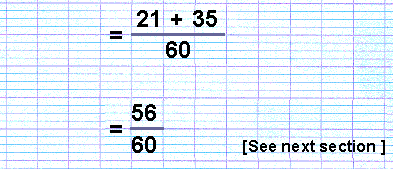
Now the big combined fraction sum is simplified by doing the various multiplications inside the brackets, and then the addition.
Tidying up and another form of balance.

As we saw briefly earlier, a half is equal to two quarters. You can easily see, dividing both the top and bottom of the fraction 2/4 by two gives 1/2, and of course, multiplying the top and bottom of 1/2 by two gives 2/4, thus maintaining the balance between the top and the bottom of the fraction.
As long as you multiply, or divide, both top and bottom by the same number, the balance will remain the same. As noted before, multiplication and division are opposites, or reverse (reversing) operations.
Fractions are are a form of ratio. Three-quarters is ‘three to four’ or ‘‘three out of four’. So as long as you keep the balance, for example six to eight’ or ‘twelve to sixteen’, the fraction does not change value and the ratio is preserved.
However, if you add, or subtract, the same number to the top and bottom of a fraction, so 1/2 becomes 2/3 by adding one to both the top and the bottom of the fraction 1/2, and the ratio or value is destroyed. [3]
Now some worked examples.
First 56/60, the result found for the mixed-up fraction
addition, 7/20 + 7/12
7/20 + 7/12 = 56/60
The long way to cancel is to divide both top and bottom, 56 and 60, by 2 - the smallest prime number, until you can divide no more. Then, if it is possible, you continue with the next prime number. This is a bit like finding the biggest common bits (or lowest common factor).
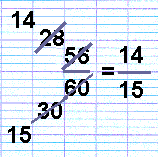
As you gain more experience, you will perhaps notice straightaway that 56 and 60 are divisible by four (2 x 2).
Next let’s cancel down the fraction 12/15.
15 is not divisible by 2, so we start dividing both top and bottom with the next prime number, 3.
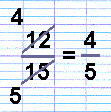
When cancelling down a number greater than one, turn the number into a fraction including a whole number (an ‘improper’ or top heavy fraction), and do the cancelling to that. For instance, in the addition sum 1/4 + 1 1/2 + 1 3/4, the sum is turned into 14/4, which cancels down to 3 1/2.

Until we reach putting in details in this section, 1/10 is written as ·1, that is a point (or dot) before the one, and one quarter is written as ·25, that is 25/100, and so on.
Adding decimals and subtracting decimals is no different from adding or subtracting any other numbers, beyond the necessity of keeping the decimal points lined up. It is easy to practise this with the calculator below.
Some examples:
• 2·43 +1·68 = 4·11 To replicate this sum using the abelard.org maths educational counter,
- Reset Counter Value to 1·68;
- Set Decimal Places to 2;
- Change Step to 2·43;
- Switch Direction (if necessary) to Increasing;
- Now click on the Manual Step button once.
• 4 + ·09 = 4·09
When calculating with decimals, it is important to lay out the numbers with the decimal points lined up. In order to help the learner to keep clear in their own mind what is happening, it can be helpful to add extra zeroes, shown in the example to the left.• 2·43 - 1·68 = ·75
This subtraction sum is handled like any other subtraction, as is explained in detail on the writing down sums page. Again, make sure that the decimal points are lined up as described above.
[This counter functions with javascript, you will need to ensure that javascript is enabled for the counter to work.]
The full version with more detailed instructions, go to the introduction page.
Thus, to practise sums with decimals, for example ·25 x 4,
The counter counts up: 0, ·25, ·5, ·75, 1. Thus ·25 x 4 = 1.
Now help the learner to try other multiplication sums. Each time, click the red Reset button to return Manual Steps (the red number) to zero.
Below is a concise version of the Brilliant abelard.org educational maths counter. For an expanded version with more detailed instructions, go to how to teach your child number arithmetic mathematics - introduction.
You are welcome to reproduce this configurable
counter. However, all pages that include this counter
must display a prominent and visible link to: © 2009 abelard.org |
|||||||||||
100% (one hundred percent) is a whole cake. 1% is 1/100th (one hundredth) of the cake.
1/10th (one tenth) is written as 10%, that is a percent sign (%) after the ten, and one quarter is written as 25% and so on.

nine one hundredths, or 9/100, or 9%, or ·9
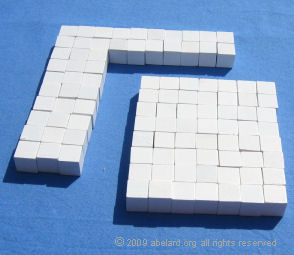
fifty-six one hundredths, or 56/100, or 56%, or ·56
It is necessary to remain alert to the following facts:
Adding percentages and subtracting percentages is no different from adding or subtracting any other numbers, or fractions (remember that 1% is one hundredth of something).
For more advanced compound percentages/interest rates, see the sum of a geometric sequence: or the arithmetic of fractional banking (compound interest).
Ratios are very similar in behaviour, but can be used rather haphazardly. For example, 3:1 (three to one) can mean that for every one apple there are three oranges. Notice that in such usage, there are four real objects, the three apples plus the orange.
Another usage is in betting, where you may may have odds of four to one. This tends to mean that you bet one pound, dollar or euro in the hope of winning four sponduliks back for every one you lay out. Usually, if your horse or camel wins, the bookmaker will pay you both the four zelottis for your winning plus the one zelotti of your original bet. This sort of bet is often termed as “four to one against”.
If the ratio is expressed the other way about, that is 1:4, it is referred to “four to one on”. In other words, for every four you bet, you will gain one and, of course, receive back you stake of four. So you receive five for an outlay of four - if you win. These are the sort of odds you are offered if you have a very good chance of winning, or even too good a chance of winning.
It is always wise to be very clear on definitions when ratios or percentages are being quoted, and to remember that most gambling is a tax on stupidity.
Farmer asks his dog to get the sheep in. The dog goes out, comes back and says I've got them. Farmer says have you got them all? Dog says I've got 40. Farmer says I've only got 36. Dog says I've rounded them up.
There are times when you don't want to refer to a number, because it is very large like 6,303,589,102, or a decimal like 3.14159265358979323846264338. In such cases, the number can be changed to a simple number of a value close by.
Because we use the decimal system, our culture tends to round (change) to the nearest appropriate number ending in zero - to ten, a hundred, a thousand etc.
The general convention used for rounding is,
If the last digit is 4 or less, the complete number is rounded down to the nearest number ending in zero.
For instance, 5.1 would be rounded down to 5.
If the last digit is 5 or more, the complete number is rounded up to the nearest number ending in zero.
For instance, 5.6 would be rounded up to 6.
In the examples we gave, 6,303,589,102 could be rounded to 6 trillion or 6.3 billion, depending on the degree of accuracy wanted.
3.14159265358979323846264338 is an partially expanded version of π [pi]. A usual rounding is 3.14.
So 3.14159265358979323846264338 is
an approximation of π to 26 decimal places, while 3.14 is rounded to 2 decimal places. 3.1416 is π to four decimal places. Here, the fifth decimal place (9), being bigger than 5, signals rounding up the fourth decimal place (5) to 6.
Note that this makes the number concerned less accurate, an approximation.
| sums will set you free includes the series of documents about economics and money at abelard.org. | |||
| money bookers information | e-gold information | fiat money and inflation | |
| calculating moving averages | the arithmetic of fractional banking | ||
| You are here: how to teach your child
number arithmetic mathematics - fractions, decimals, percentages and ratios < sums will set you free < Home |
© abelard, 2009, 1 may the web address for this page is https://www.abelard.org/sums/teaching_number_arithmetic_mathematics_fractions_decimals_percentages1.php 5,840 words |